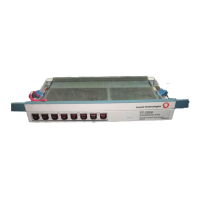Administration and Provisioning
8-26 Issue 8.0 July 2002
The transmit side of the DS3 circuit pack in low speed interface slot 6B and the
receive side of the DS3 circuit pack in low speed interface slot 2A are available for
one of the following:
■ They can be cross-connected to an STS-3 tributary in the opposite
direction to complete a 2-way application.
■ They can be cross-connected to another STS-3 tributary for another 1-way
through-cabled STS-1 tributary application.
■ They can be used independently for various types of 1-way applications.
■ They can be unused.
When the STS-1 tributaries associated with a single STS-3 tributary are split up,
the STS-3 tributary source and destination node provisioning is no longer correct
for the STS-1 tributaries. The CONFIGURATION-Enter-Squelch Map-STS1
input must be used to override the STS-3 squelch map provisioning for those
STS-1 tributaries. This STS-1 squelch map provisioning must be done at each
node where the affected STS-1 tributary(s) is terminated, looped back using
external cabling, or passed through using STS-3 through cross-connections.
STS-3 Cross-Connection Restrictions 8
STS-3 cross-connections cannot be made from one low speed interface slot to
another low speed interface slot or between two differently numbered STS-3
tributaries.
Limited STS-1 cross-connections have the following restrictions:
■ Any STS-3 tributary that is part of a 1-way-DRI or drop and continue
(bridge) cross-connection at an FT-2000 OC-48 Add/Drop-Rings Terminal
cannot have through-cabled STS-1 tributaries.
■ If the CONFIGURATION-Enter-Roll-STS3 input is used to move a
cross-connection from slot to slot for a cross-connection that has
through-cabled STS-1 tributaries, the through-cabled STS-1 tributaries will
be disconnected until the external cables are moved at the cross-connect
panel.
■ When DS3 circuit packs are used, the through-cabled STS-1 tributaries
have their path overhead terminated and are desynchronized and
synchronized (the DS3 is cabled through, not the STS-1). This affects the
interpretation of performance-monitoring data (for example, B3 errors will
not be propagated through to the final destination).

